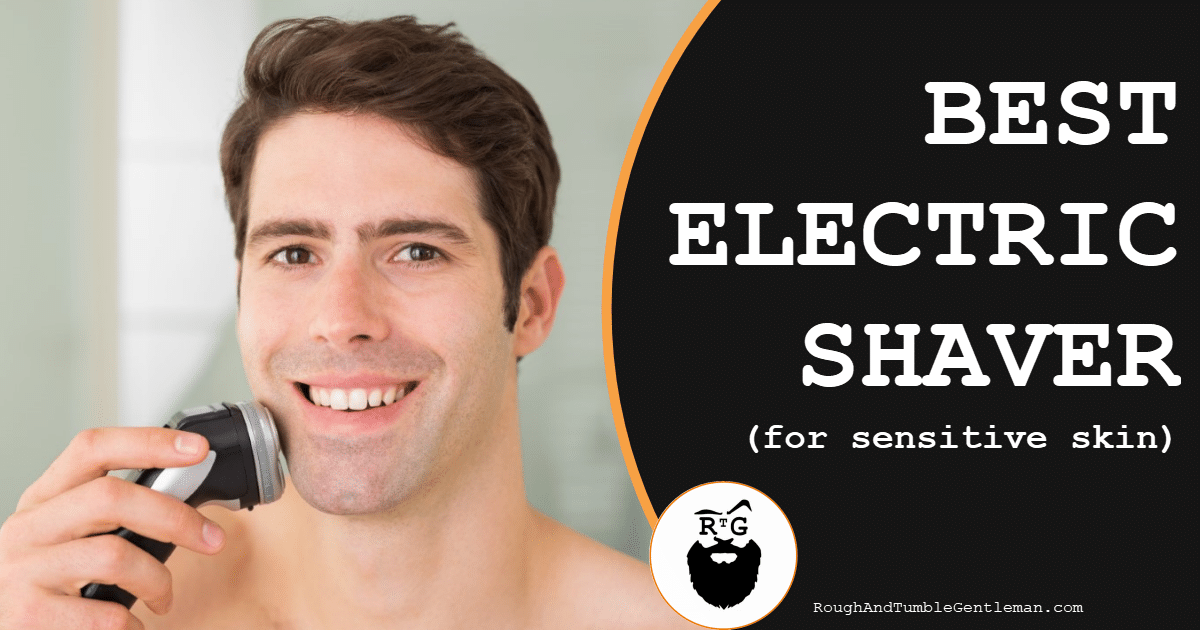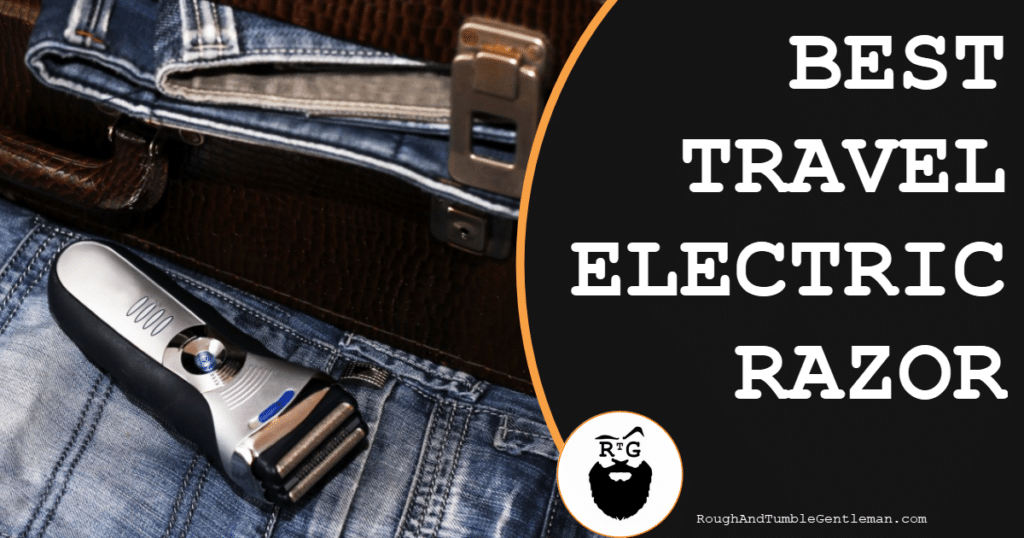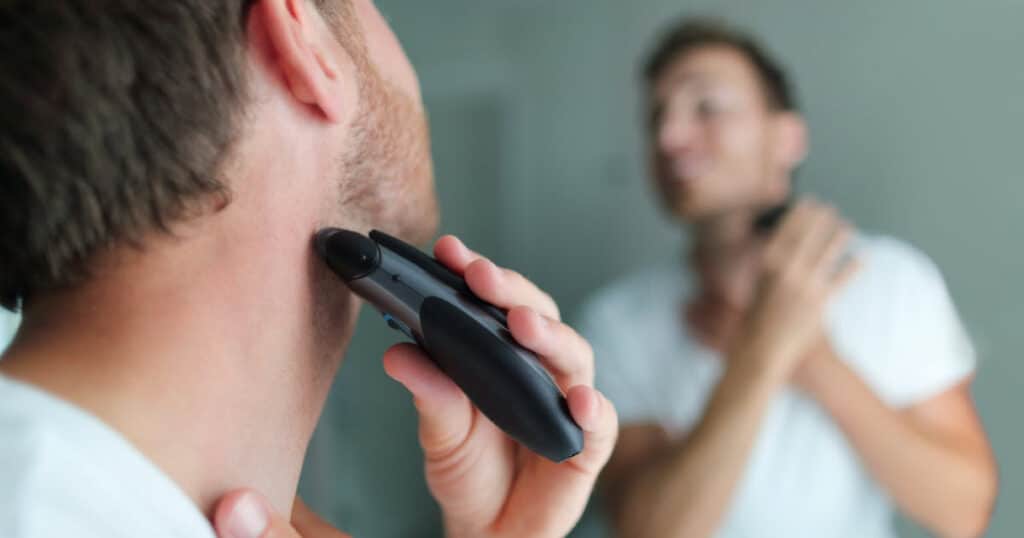You know what’s wonderful? A smooth, comfortable shave that removes all your facial hair and leaves you looking dapper and handsome. Fantastic!
You know what’s not wonderful? The carnage that poorly-made electric shavers can do to your face, and the bumpy red battlefield that used to be your skin. NOT wonderful. Not wonderful at all.
Sooooo, with that in mind, here we’ll be talking about our picks for the best electric shaver for sensitive skin. There are some great sensitive skin shavers out there, but it can be a little tricky to find the right one—especially if you’re concerned about bumps, itchiness, and irritation.

Let’s get to it:
Electric Shavers for Sensitive Skin: Review Summaries
We’ll get into the details in a moment, but here’s a quick overview of our recommendations, and why:
Best Overall (tie): The Panasonic Arc5 Electric Razor—This is our best all-around pick, that can provide a close shave without the bumps, cuts, and irritation that other shavers can create
Best Overall (tie): The Braun Electric Razor for Men—This is our “luxury” pick, and with its AutoSense tech, contouring ability, and long charge, it’s about as good as a sensitive skin shaver can get, and it can be great for thick facial hair
Best “Just the Basics” Option: The Braun Series 3 ProSkin—Electric shavers can get pretty fancy, but if you’re looking for one with all an uncomplicated, easy-to-use model designed for sensitive skin, this is the one we suggest
Best Ergonomic/Easy-to-Maneuver Option: The Panasonic Arc4 Electric Razor—A model that “punches above its weight,” the Arc4 moves a little more gracefully than other models, and can be a good option if you have difficult reaching those hard-to-get-to spots on your face
Best Rotary Option for Sensitive Skin: The Philips Norelco Shaver 7700—As a general rule of thumb, you’ll want to go with a foil shaver if you’ve got sensitive skin, but this model from Philips Norelco is designed specifically for guys wanting a rotary shaver that provides a close-but-gentle shave.
And there you have it! Now let’s get into the details and flesh all this out:

The Best Sensitive Skin Electric Shavers: Our Picks, and What They’re Good For
Alright! Here’s the nitty gritty about each model—what we like and don’t like about each model. First up:
The Braun Series 3 ProSkin
Summary: An easy-to-use model that doesn’t overcomplicate things, but can still provide a gentle, close shave.
We’ve written a lot about Braun, and they’re a fantastic company. Every single series of shaver they’ve put out has been a great enhancement over the last one—and the funny thing is, their original shavers were pretty darn excellent! So, if you’re looking for a “kind of dated but still functional and fantastic” shaver for sensitive skin, the Braun Series 3 ProSkin may be a great pick.
We think it’s a great option for guys with sensitive skin for a couple of reasons: 1) it’s a foil, and foil models are a great option for men with sensitive skin because they’re specifically designed to be used in straight, single lines over the area to be shaved. Because more passes = a higher chance of skin irritation, your odds of an irritation-free shave greatly increase if you never shave over the same area twice; 2) It’s got pressure-sensitive blades. This is a feature you don’t often see in older razors—the ability of the blades to pull back a little bit if they’re getting too close to your skin; and 3) It’s an older model, but it’s still got wet/dry capability. If you find that dry shaving is making you raw and/or irritated, you can see if using the ProSkin with shaving cream is easier on you.
This is an older model, so it doesn’t have some of the perks of later models—most notably, the shaving head doesn’t move, so you’ll need to deftly manipulate the shaver to get to those hard-to-reach areas—but all-in-all, we think it’s a great shaver, and a great example of how something doesn’t need to be the newest and shiniest model to be effective.
The Panasonic Arc4 Men’s Electric Razor
Summary: If you’re looking for an option that can go easy on your skin, but have had difficulty using a foil that can get to all parts of your face, this can be a effective option.
The Panasonic Arc4 Men’s Electric Razor is another shaver that isn’t the newest model, but performs at a very high level. It’s got four “Micro-Fit” blades (that is—four super-thin blades underneath the foil) designed to provide an incredibly close shave; a motor that operates at 14,000 cycles per minute (that’s the “CPM” that they refer to in the instruction manual—very fast, and an improvement upon past models); and, finally, it’s waterproof with wet/dry capability, meaning that you can use it in the shower, and with or without shaving cream or gel. It’s also got some very nice features, like the pop-up shave trimmer and an easy-to-read LCD display. Charge it, shave with it, rinse it underwater when you’re done using it—nice and simple.
But, the most important thing is how it performs for men with sensitive skin, and it’s got two fantastic features going for it: the foil, and the blades beneath them, are hypoallergenic, making them a great option for men who may experience irritation from regular metallic blades. And—remember the 14,000 cycles per minute we mentioned above? That enhanced speed is designed to reduce some of the “tug” that you feel with other razors, because that “tug” can irritate the heck out of your epidermis. The enhanced cuts-per-minute is a great feature to have if you’re doing a single pass, and a truly great feature if you have to do more than one pass, because it can enable you to complete your shave more quickly. If you hate standing in front of the shower every morning and want to speed things up, a higher CPM can be a boon.
As far as mid-range shavers go, there are a couple that we like, but this is definitely our favorite in this category, and it gets our vote as best electric shaver for sensitive skin when it comes to mid-range options.
The Philips Norelco Shaver 7700
Summary: If you 1) have sensitive skin, and 2) are looking for a rotary shaver, there aren’t too many we recommend, but we’re big fans of this one.
In most cases, we advise guys with sensitive skin to stay away from rotary shavers, because they can be a LOT more harsh on the skin. The circular motion of the blades, combined with the circular method of passes over the skin, make them a “no-go” for guys with skin issues, and foil shavers—with their simple, back-and-forth motion—are usually the better bet.
That said, there are a few rotary shavers that are designed for guys with sensitive skin, and of them, we usually suggest the Philips Norelco Shaver 7700. It is—regardless of whether you’re looking for a sensitive skin option—one of the best shavers out there. It’s got:
> 90,000 cutting actions per minute, which translates to 1,500 cutting actions per second (and honestly, we’re not really sure how that’s possible);
> 360-degree contour heads that adjust to the surface of your skin, so that blades aren’t “searching” for whiskers to tug on;
> A wet/dry option so that you can use it with or without shaving cream and/or gel, and use it in front of the mirror or in the shower if you want to.
When you couple that with its sensitive skin features—specifically, its ComfortGlide rings, which feature a special coating to shield the epidermis from irritation, and a cleaning pod that cleans the model so that left-over gunk and biomaterial don’t aggravate your skin—you’ve got a rotary that can be a great choice for our sensitive-skinned brethren.
All that said, if we could offer one word of advice, it would be to go slowly as you shave—it seems like a lot of guys like rotary shavers because they feel like that can use them quickly. If you’ve got sensitive skin, you really don’t want to do that—you want to take it easy. That’s true for all electric shavers, but definitely true for a rotary. The Philips Norelco 7700 isn’t quite like other rotaries—most rotaries are NOT designed for sensitive skin, and this one is—but you still want to take things slow.
That said, if you’re looking for a rotary shaver for sensitive skin, this is the one we suggest. Philips Norelco makes some really fantastic shavers, and we’re happy to include this model in our recommendations.
The Panasonic Arc5 Electric Razor
Summary: The Arc5 is one of those shavers that surprised us, and performs with more smoothness and stability than expected, and is tied as one of our top two recommendations.
One of the best features of the Panasonic Arc5 Electric Razor—and one of the reasons it can perform so smoothly—is the blades: they’re set at 30 degrees, and that gradient is designed to provide Panasonic shavers the optimal angle to cut whiskers. That actually makes a big difference when it comes to skin sensitivity—shavers that attack whiskers are too aggressive (or too lax) and angle can be ineffective and may require more passes, and as we mentioned earlier, more passes = more irritation.
So the general set-up of the shaver is manufactured to provide an effective delivery for whisker removal. But it has (as you’d imagine), some very technical-sounding features that add to the closeness of the shave: a “Hyper Performance” linear motor, which allows the shaver to cut whiskers at an incredible speed; a shaving sensor, that allows the razor to kick it up a notch (or calm itself a bit) depending on the thickness or sparseness of your facial hair; and a pivoting head with Multi-Flex capability, which basically means that each of the cutting surfaces (and there are five of them, because this is the Arc “5”), can rock back and forth as they travel over your skin, making it a good match for uneven surfaces. Also, as with most electric shavers, a pop-up trimmer function provides some styling capability.
That’s all wonderful, but the real benefit of the Arc5 is its ability to handle sensitive skin. It’s got two factors that make it stand out from other models: 1) it’s manufactured with hypo-allergenic “Nanotech” blades, which are incredibly thin and travel right beneath the foil to chop whiskers and reduce “pull,” and 2) that “Hyper-Performance” linear motor that we mentioned earlier allows the shaver to operate at 14,000 cycles minute. Those blades are moving very fast, and that speed allows the razors to cut whiskers before they leave the perforations in the foil, making the shave feel (in our experience) a lot of smoother. And, finally, because it’s a waterproof wet/dry model, you can use shaving gel or cream to lubricate your skin before use. We dig the Arc5s.
And finally…
The Braun Electric Razor for Men
Summary: This is our suggestion if you’re looking for a feature-rich, luxury model designed for sensitive skin. This is one of our top picks for an electric shaver, even for guys without sensitive skin.
The Braun Electric Razor for Men is our other “Best All-Around,” and it too has some pretty impressive features that are common among high-end razors:
> “AutoSense” technology that allows the shaver to “read” your facial hair, and ramp up or ease down as necessary;
>”10-D Contour Adaption,” which basically means that the shaving surfaces can ease back and forth in ten directions, to more comfortably canvas your face; and
>Titanium-coated trimmers, that catch flat-lying or irregularly-growing whiskers.
Just like the Arc5, it’s got five different shaving elements, and we’ve known it to provide an exceptionally close shave, and it’s a wet/dry, waterproof model, so you’ve got plenty on options on how to use it. In our experience, it’s fast, effective, and easy-to-use. Another fantastic model, and in our opinion, worth checking out—we think it’s one of the best-performing shavers out there.
OK! Those are our favorite shavers for guys with sensitive skin—hopefully we’ve decoded some of the terminology, and provided some clarity on which models might be a good option. If you have any questions about sensitive skin shavers or how to select them, jump over to our “Contact” page and drop us a line—we’d love to hear from you!

Electric Razors for Sensitive Skin: A Quick Buyer’s Guide
We mentioned above that electric shavers can be VERY complicated. There’s a weird sort of jargon that manufacturers use when describing them, and a lot of the features are named in a way that doesn’t really explain what they do.
So here, we’ll go over much of what you need to know in order to select a shaver that works for you. We’ll start with…
The Basics. If you’re completely new to electric shavers, here are the absolute basics you need to know about:
Types of Shavers. There are two types of electric shavers: rotary shavers and foil shavers. Rotary shavers are the models that have three circular discs at the top of the device; foil shavers have a flat, rectangular shaving surface. While they both provide a very close shave, there are a few notable differences between the two: foils are used in a straight line over your skin, are great for straightening up sideburns, goatees, and beards, and typically provide a closer shave the rotaries (and Braun is a big name in foils); rotaries can be used in a circular motion over your skin, are better for shaving hairs that grow in different directions or coarser hairs, and are a little easier to use than foils (and Norelco is a big name in rotaries).
Both have their pros and cons, but if you’ve got sensitive skin, foil shavers are usually a better bet. In our experience, they’re less likely to pull at your whiskers from odd angles, less likely to produce ingrown hairs, and less likely to cause irritation. There is a little bit of debate when it comes to foils and rotaries and how they perform on sensitive skin—there are some rotaries that can work great for men with sensitive skin, and we’ve had great luck with the Philips Norelco Electric Shaver 7500 for Sensitive Skin (which we’ll review below)—but as a general rule of thumb, foils are the better option.
Wet/Dry Capabilities. The “wet/dry” functionality refers to your ability to use the shaver “wet” (that is, with shaving cream and/or gel on your face), or “dry” (without any shaving cream and/or gel on your face). Most electric shavers made in recent years have wet/dry functionality—you’d actually have to search around for a dry-only shaver—but it’s definitely something to look for, because wet shaving is a LOT easier on your skin. Dry shaving can really do a number on your face, and using creams or gels can really make things more comfortable.
Waterproof Features. This is closely related to the “wet/dry” capability: waterproof shavers are easy to clean under running water from the faucet, and most are safe to bring in the shower. This is another very common feature with electric shavers, but if you plan on using your shaver in the shower, you’ll obviously want to be certain the model you choose is waterproof.
Manufacturers of Electric Shavers. This is, perhaps, one of the most helpful paragraphs in this entire post, and that’s because it seems like there are thousands of different makes and models of electric shavers. Basically, there are four main companies that make electric shavers: Braun, Philips Norelco, Panasonic, and Remington. There are a lot of other companies that make them—new players in the game—but those four companies are the ones that have the most name recognition, and a lot of them have a great deal of customer loyalty.
Here’s how it breaks down: Braun is perhaps the biggest player in the game, and they focus on foil shavers; their main competitor is Panasonic, who also focuses on foil shavers; Philips Norelco primarily makes rotary shavers, and they dominate that space; and Remington makes both foils and rotaries, but they tend to be nuts-and-bolts, “no frills” models. If you want a foil shaver, chances are you’ll want to look at Brauns or Panasonics (and we’ll talk about all that below); if you want a rotary, you might want to check out a Philips Norelco; and if you want a “lo-fi” model, you may want to consider a Remington (although, to be honest, we don’t know of any Remingtons that are manufactured for guys with sensitive skin, and we don’t review any Remingtons in our “Reviews” section below).
Model Lines. Now that we’ve introduced the makers of electric shavers, let’s take a minute and “de-code” their product lines, because that will also help you make an informed decision about a model you’re interested in. Braun releases their shavers in different “Series”—Series 1 was their original offering, and then Series 3 after that, then Series 5, Series 7, and Series 9. Each “Series” is a little bit more capable than the last, and offers a closer shave and more features. Panasonic releases their shavers in “Arcs”—the Arc3 is an older model, and has three cutting surfaces; Arc4 is newer than that, and features four cutting surfaces; Arc5 is—you guessed it—newer than that, and features five cutting surfaces. Philips Norelco’s original series was Series 1000, and then 2000, 3000, 4000, 5000, 7000, and then 9000 (they skipped 6000 and 8000, for some reason).
Braun, Panasonic, and Philips Norelco each offers a number of products in each product line—so, for example, in Braun’s Series 7 line, they offer the Series 7 7899c, the Series 7 7898c, the Series 7 7865c, and so on. Most of the features in a particular model line have the same main features, and each model has very small differences.
Sensitive Skin Models. There are some shavers that are made specifically for men with sensitive skin (the Panasonic 7500, which we mentioned above, is one; we’ll talk about more below), and there are others that are regular shavers but have different settings, with “Sensitive Skin” being one of those settings. In our experience, both the models with a “sensitive skin” feature and the models made specifically for men with sensitive skin are good options (and they can be great electric shaver options for older gentlemen).
Features. Electric razors usually have a couple of characteristics that people usually look out for. They include: a pop-up trimmer, that will allow you to shape your sideburns / mustache / goatee / beard; length settings, that let you vary the length of whiskers as you shave them (and settings usually range from something like “super-close shave” to “short beard”), and a charging station that doubles as a cleaning station (which is a pretty sweet feature). Each model has different features, and it’s up to you to determine what you want.
Most of the features, though, are designed to increase the closeness of the shave, and companies can REALLY get into the weeds with the names that they give to their patented technology. Braun is probably the biggest offender on that score: they boast the “SynchroSonic” technology, “OptiFoil” closeness, “2x MacroMotion,” and so on, and that all sounds great, but what does it actually MEAN? Some guys truly appreciate those terms, while some other guys are bored to tears by them, and find them confusing.
Basically, all that “tech talk” basically means that manufacturers trademarked a new technology to bring you a smoother and closer shave, and as a general rule of thumb, newer shavers offer a closer shave and more features. The new technology in each new line of products (and those little machines really do have a lot of tech in them) usually advances the capability of the products that came before it. If you’re interested, we’ll get into detail about all those terms below, but if you don’t want to be burdened by all that, keep in mind that “newer” usually equals “more advanced.” That’s not always true, but companies really do put a lot of effort into research and development, and it’s true a lot of the time.
Battery Life and Recharge Ability. This is another area where electric shavers have truly advanced over the years—many of the high-end shavers can keep 50 minutes of charge after only an hour being plugged in, and many have a “quick charge” ability, where you can plug them in for about five minutes, and they’ll last through an entire shave. If you’re on a schedule where you’re simply going to plug in your shaver after each use, this may not be the most important feature to you, but if you travel a lot or keep an irregular shaving schedule, it can be worth looking into.
Warranties. Many shavers come with a warranty, and the general trend is a two-year warranty, but it’s definitely something to note when you’re comparing different models. Also, not every warranty is the same—some may cover the entire shaver, whereas others may omit certain parts from the warranty (like the foil itself).
So, there you have it! A crash course on what to keep in mind when you’re looking for the best electric shaver for sensitive skin for your needs. Now let’s take a look at some…
Shaving Tips for Men with Sensitive Skin
If you’ve got sensitive skin and shaving is sometimes a torturous experience, we feel your pain—literally. Having sensitive skin and shaving can be agonizing, so here are a couple of tips to make things more comfortable.
Always Making Sure You’re Using Sharp Blades. This is true whether you’re using an electric shaver, a cartridge razor, or a safety razor or straight razor: always make sure you’re using a sharp blade. Not only do blunt blades do a lousy job of shortening whiskers, they’re also a great way to experience irritation and rashes.
If you’re using an electric shaver, you’ll usually need to replace the shaving head every year to year-and-a-half (and the instructional packet that comes with your shaver should tell you exactly when you need to replace the head). If you’ve lost instructions, you’ll have two clues that’ll let you know it needs to be replaced (and the first is pretty obvious): 1) It’s providing a lousy shave; and 2) It “pulls” at your whiskers. Electric shavers with properly-sharp blades will cut your whiskers without that tugging feeling on your face, so as soon as the shave feels different and you feel like the device is pinching you, you may want to think about the last time you replaced the head.
And, just for general reference—disposables last anywhere from three to five uses; cartridge razors last anywhere from five to ten shaves; and the razor blades you’d use in a safety razor last about five shaves.
More Passes = More Irritation. We mentioned this above, but we’ll repeat it here: the more passes you use during a shave, the higher your chances of experiencing skin irritation. That’s one of the reasons why a lot of guys have skin troubles with rotary shavers—rotary shavers are designed for multiple passes over the skin in a sort of “free-form” technique.
So if you can, really focus on what you’re doing, and take it slow—see if you can get a close shave with only one or two passes. Be mindful and practice your technique as you shave, and see if you can remove all the whiskers you want to remove in a single pass.
Take a Look at Your Shaving Cream. There is a LOT of weird stuff in some shaving creams, and it’s worth taking a look at the brands you use to see if you can figure out why your skin is irritated. Seriously—among the many odd ingredients in shaving cream is propane, just like the gas in your grill, and it’s used to push the shaving cream or gel out of the can you bought. It’s obviously not there because it’s good for you—just like a lot of the ingredients in your shaving cream (and most of your other products), it’s included for functional reasons, and not for health reasons. The same goes for all the dyes and other chemicals added to skin care products—they’re there to make the product easier to use, or more attractive, or longer-lasting, and a lot of them just aren’t good for you.
This is all to say, if you’re consistently breaking out, getting rashes, or experiencing bumps, take a look at your shaving cream, and all the other substances you put on your face when you shave. And the same goes for your equipment—if you’re experiencing irritation with a rotary shaver, a foil shaver might work better for you; if foils and rotaries irritate your skin, maybe it’s time to try traditional wet shave (and we’ll talk more about that in a minute).
And that actually leads us to another issue when it comes to products you use on your skin: the “keywords” companies use to market them.
Try Hypoallergenic and Non-Comedogenic Products. These are two words you’ll see a lot if you’re looking for sensitive-skin products. “Hypo-allergenic” means the product is less likely to cause an allergic reaction, and “non-comedogenic” means that the product is less likely to cause you acne. And that’s great, but—what are the actual laws concerning these two terms?
The sad fact is, neither of these terms have any legal meaning (to see what we mean, take a look at the FDA’s definition of hypoallergenic). There are no laws or rules or regulations that require a hypo-allergenic/non-comedogenic product to include, or not include, any particular set of ingredients. When a company makes a product and uses either of these two words to market it, all it means is that they’ve created the product without ingredients that they believe to cause allergies or acne.
So are hypo-allergenic and non-comedogenic products worth looking for? Sometimes yes, sometimes no. Most companies do try to create a product that’s easy on the skin, but in terms of actual results, it’s hit-or-miss: some guys find that hypo-allergenic/non-comedogenic products keep them from experiencing rashes or inflammation or acne, while others find that hypo-allergenic/non-comedogenic products don’t do anything, and they still experience skin issues.
It’s another one of those areas where you’ll have to find out what works for you, but in our opinion, it’s definitely worth trying—we’ve have good results with them, but obviously your personal results may vary, and they’re not a guaranteed thing.
Don’t Go Nuts with Your Cleansing Regimen. This is another area where we speak from experience: if you’ve got sensitive skin or are prone to breakouts, you may be tempted to cleanse your skin more than you need to. You may be tempted to wash your face too often, use strong deodorant soaps that strip your skin of its oils, or exfoliate too aggressively. If you’ve got sensitive skin, it makes sense that you’d want to take steps to fix it, and you’d want to keep trying until you figure it out. There are a lot of problems where “trying harder” will help you find a fix sooner—but sensitive skin is not one of those problems.
In fact, over-doing it may actually worsen your issues. It’s an “easy-does-it” sort of thing, and the American Academy of Dermatology provides a very simple, very clear set of instructions on how to correctly wash your face. Basically, use a gentle cleanser that doesn’t have alcohol in it, use your fingers instead of a washcloth (and be gentle!), and limit your washing to twice a day. They also suggest that…
Moisturizers Can Help. There are a lot of guys who experience irritation when their skin gets too dry, and there’s a really easy fix: moisturizers. They introduce liquid to skin, keep it in your pores, and depending on the type you buy, they can also deliver vitamins (like Vitamins A, C, and E, all of which are great for your skin) and antioxidants that can maintain skin health (like green tea and grapeseed).
A lot of guys are a little reticent to start moisturizing. They imagine it takes a long time, or that you need to do re-apply it during that day, or that it’s a traditionally “feminine” thing and not worth doing. The good news is, it’s quick and simple and very masculine: there are aftershave balms you can use that do a great job moisturizing your skin, and you can simply rub them into your face after you’re done shaving. Easy peasy.
Consider Traditional Wet Shaving. There are some guys who simply can’t use an electric shaver without experiencing in-grown hairs, bumps, or rashes, and a good number of those guys experience a lot of relief when they try traditional wet shaving.
These terms overlap a little bit, because above, we defined “wet” shaving as “using shaving cream to shave.” “Traditional wet shaving” is different—traditional wet shaving is when you use all-natural shaving creams or soaps, a shaving brush to create a lather and spread it over your face, and a safety razor or straight razor to cut your whiskers. It’s an old-school method of shaving—it’s usually described as “the way your grandpa used to shave”—but it’s a lot simpler, and because it only involves a single razor blade against your skin (compared to the multiple blades in an electric shaver, or the multiple blades on a cartridge razor), it can be a lot easier on your skin. Plus, the all-natural shaving creams and soaps can be a lot less likely to cause inflammation and rashes.
The one for-sure negative to wet shaving is that it takes longer than shaving with an electric shaver. With a good electric shaver, you can get a decent shave in five to ten minutes, whereas most wet-shaving sessions will take you fifteen minutes or more, even when you get good at it. If electric shavers are truly irritating your skin, though, that extra time it takes to shave with a safety razor or a straight razor can be worth it.
We’ve written a great deal about traditional wet shaving, and you can learn more by visiting any of the posts in our sidebar.
Good Luck!
If you’ve got sensitive skin, you probably know first-hand how difficult it is to find products that aren’t going to irritate you or make you break out. Hopefully our guide has helped a little bit. Be good, and happy shaving!
Michael Morris is the head writer here at Rough and Tumble Gentleman. He's got a ducktail beard and loves Brazilian jiu-jitsu. He's married to the woman of his dreams and lives in Brooklyn, NY.









